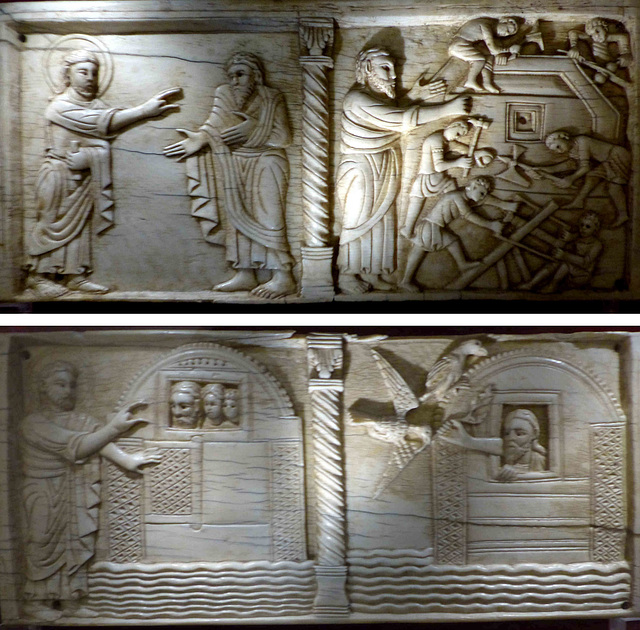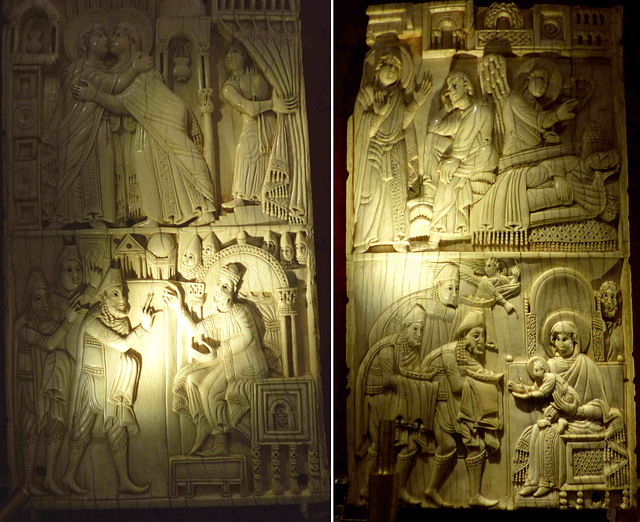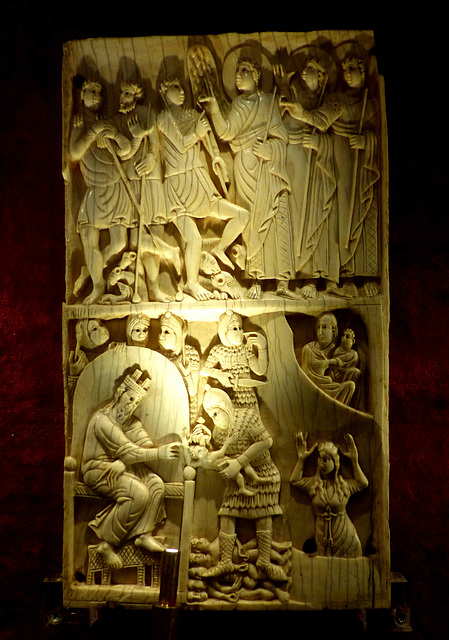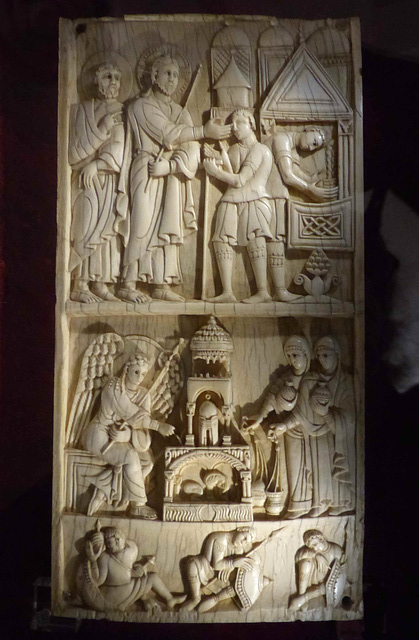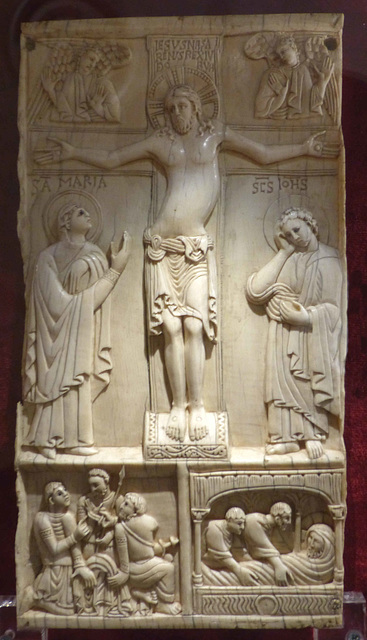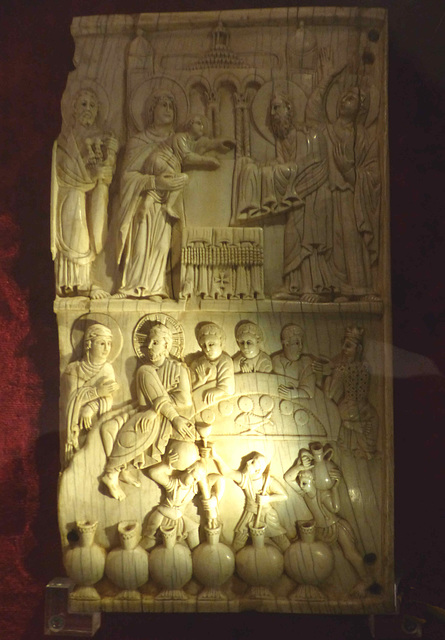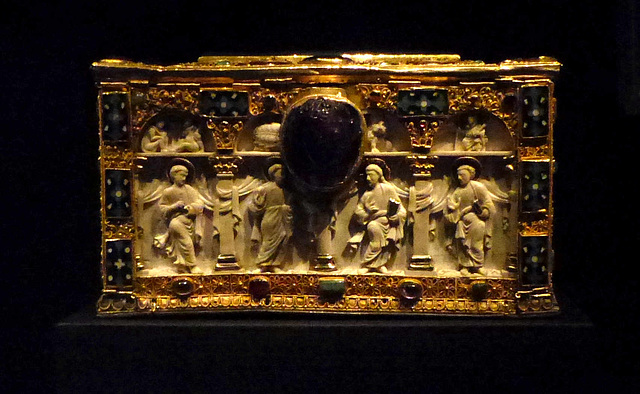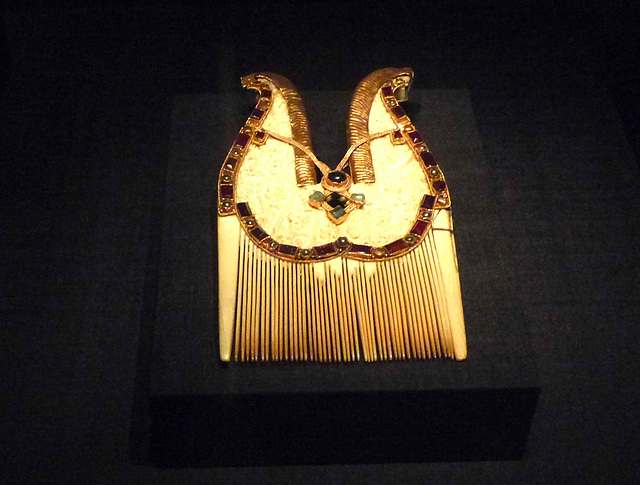
Ivory
01 Feb 2022
Salerno - Museo Diocesano San Matteo
Salerno (pop. ~ 130.000) is located on the Gulf of Salerno on the Tyrrhenian Sea. The site has been one of the most important and strategic ports on the Mediterranean sea, yielding a rich Greco-Roman heritage. It was an independent Lombard principality in the early Middle Ages. The Normans in 1077 made Salerno the capital of their rule in all of southern Italy. In the 16th century, under the Sanseverino family, among the most powerful feudal lords in southern Italy, the city became a center of learning, culture, and the arts.
Salerno has been the seat of an archbishop since 983 and the city's medical school is famous for being the first college or "university" of medieval Europe.
The Diocesan Museum is best known for the "Salerno Ivories". A collection of ivory plaques from around the 11th or 12th century that contain elements of Early Christian, Byzantine, and Islamic art as well as influences from Western Romanesque and Anglo-Saxon art.
It is the largest unified set of ivory carvings preserved from the pre-Gothic Middle Ages and depicts narrative scenes from both the Old and New Testaments. It is supposed the ivories originated in either Salerno or Amalfi, which both contain identified ivory workshops, however, neither has been definitively linked to the plaques so the city of origin remains unknown.
Noah´s ark
Salerno - Museo Diocesano San Matteo
Salerno (pop. ~ 130.000) is located on the Gulf of Salerno on the Tyrrhenian Sea. The site has been one of the most important and strategic ports on the Mediterranean sea, yielding a rich Greco-Roman heritage. It was an independent Lombard principality in the early Middle Ages. The Normans in 1077 made Salerno the capital of their rule in all of southern Italy. In the 16th century, under the Sanseverino family, among the most powerful feudal lords in southern Italy, the city became a center of learning, culture, and the arts.
Salerno has been the seat of an archbishop since 983 and the city's medical school is famous for being the first college or "university" of medieval Europe.
The Diocesan Museum is best known for the "Salerno Ivories". A collection of ivory plaques from around the 11th or 12th century that contain elements of Early Christian, Byzantine, and Islamic art as well as influences from Western Romanesque and Anglo-Saxon art.
It is the largest unified set of ivory carvings preserved from the pre-Gothic Middle Ages and depicts narrative scenes from both the Old and New Testaments. It is supposed the ivories originated in either Salerno or Amalfi, which both contain identified ivory workshops, however, neither has been definitively linked to the plaques so the city of origin remains unknown.
The Magi visiting Herod / The Magi adorating
Salerno - Museo Diocesano San Matteo
Salerno (pop. ~ 130.000) is located on the Gulf of Salerno on the Tyrrhenian Sea. The site has been one of the most important and strategic ports on the Mediterranean sea, yielding a rich Greco-Roman heritage. It was an independent Lombard principality in the early Middle Ages. The Normans in 1077 made Salerno the capital of their rule in all of southern Italy. In the 16th century, under the Sanseverino family, among the most powerful feudal lords in southern Italy, the city became a center of learning, culture, and the arts.
Salerno has been the seat of an archbishop since 983 and the city's medical school is famous for being the first college or "university" of medieval Europe.
The Diocesan Museum is best known for the "Salerno Ivories". A collection of ivory plaques from around the 11th or 12th century that contain elements of Early Christian, Byzantine, and Islamic art as well as influences from Western Romanesque and Anglo-Saxon art.
It is the largest unified set of ivory carvings preserved from the pre-Gothic Middle Ages and depicts narrative scenes from both the Old and New Testaments. It is supposed the ivories originated in either Salerno or Amalfi, which both contain identified ivory workshops, however, neither has been definitively linked to the plaques so the city of origin remains unknown.
The Massacre of the Innocents
Salerno - Museo Diocesano San Matteo
Salerno (pop. ~ 130.000) is located on the Gulf of Salerno on the Tyrrhenian Sea. The site has been one of the most important and strategic ports on the Mediterranean sea, yielding a rich Greco-Roman heritage. It was an independent Lombard principality in the early Middle Ages. The Normans in 1077 made Salerno the capital of their rule in all of southern Italy. In the 16th century, under the Sanseverino family, among the most powerful feudal lords in southern Italy, the city became a center of learning, culture, and the arts.
Salerno has been the seat of an archbishop since 983 and the city's medical school is famous for being the first college or "university" of medieval Europe.
The Diocesan Museum is best known for the "Salerno Ivories". A collection of ivory plaques from around the 11th or 12th century that contain elements of Early Christian, Byzantine, and Islamic art as well as influences from Western Romanesque and Anglo-Saxon art.
It is the largest unified set of ivory carvings preserved from the pre-Gothic Middle Ages and depicts narrative scenes from both the Old and New Testaments. It is supposed the ivories originated in either Salerno or Amalfi, which both contain identified ivory workshops, however, neither has been definitively linked to the plaques so the city of origin remains unknown.
Jesus Heals a Man Born Blind
John 9, 1:6
"As he went along, he saw a man blind from birth. His disciples asked him, “Rabbi, who sinned, this man or his parents, that he was born blind?” “Neither this man nor his parents sinned,” said Jesus, “but this happened so that the works of God might be displayed in him. As long as it is day, we must do the works of him who sent me. Night is coming, when no one can work. While I am in the world, I am the light of the world.”
After saying this, he spits on the ground, made some mud with the saliva, and put it on the man’s eyes. "Go,” he told him, “wash in the Pool of Siloam”. So the man went and washed, and came home seeing."
---
The Myrrhbearers
Salerno - Museo Diocesano San Matteo
Salerno (pop. ~ 130.000) is located on the Gulf of Salerno on the Tyrrhenian Sea. The site has been one of the most important and strategic ports on the Mediterranean sea, yielding a rich Greco-Roman heritage. It was an independent Lombard principality in the early Middle Ages. The Normans in 1077 made Salerno the capital of their rule in all of southern Italy. In the 16th century, under the Sanseverino family, among the most powerful feudal lords in southern Italy, the city became a center of learning, culture, and the arts.
Salerno has been the seat of an archbishop since 983 and the city's medical school is famous for being the first college or "university" of medieval Europe.
The Diocesan Museum is best known for the "Salerno Ivories". A collection of ivory plaques from around the 11th or 12th century that contain elements of Early Christian, Byzantine, and Islamic art as well as influences from Western Romanesque and Anglo-Saxon art.
It is the largest unified set of ivory carvings preserved from the pre-Gothic Middle Ages and depicts narrative scenes from both the Old and New Testaments. It is supposed the ivories originated in either Salerno or Amalfi, which both contain identified ivory workshops, however, neither has been definitively linked to the plaques so the city of origin remains unknown.
The Crucifixion
Salerno - Museo Diocesano San Matteo
Salerno (pop. ~ 130.000) is located on the Gulf of Salerno on the Tyrrhenian Sea. The site has been one of the most important and strategic ports on the Mediterranean sea, yielding a rich Greco-Roman heritage. It was an independent Lombard principality in the early Middle Ages. The Normans in 1077 made Salerno the capital of their rule in all of southern Italy. In the 16th century, under the Sanseverino family, among the most powerful feudal lords in southern Italy, the city became a center of learning, culture, and the arts.
Salerno has been the seat of an archbishop since 983 and the city's medical school is famous for being the first college or "university" of medieval Europe.
The Diocesan Museum is best known for the "Salerno Ivories". A collection of ivory plaques from around the 11th or 12th century that contain elements of Early Christian, Byzantine, and Islamic art as well as influences from Western Romanesque and Anglo-Saxon art.
It is the largest unified set of ivory carvings preserved from the pre-Gothic Middle Ages and depicts narrative scenes from both the Old and New Testaments. It is supposed the ivories originated in either Salerno or Amalfi, which both contain identified ivory workshops, however, neither has been definitively linked to the plaques so the city of origin remains unknown.
Presentation of Jesus at the Temple / Wedding at Cana
Lyon - Musée des Beaux-Arts
Colonia Copia Claudia Augusta Lugdunum (now Lyon) was an important Roman city in Gaul. It was the capital of the Roman province of Gallia Lugdunensis. The Christianization took place very early.
In 177, the Christian community sent a letter naming 48 of their number who had been martyred. In 843 it was ceded to Lorraine and then passed to the Kingdom of Burgundy, whose dominion was entrusted to the Archbishop of Lyon by Frederick Barbarossa in 1157. In 1312 Philip the Fair incorporated Lyon into the kingdom of France.
Lyon was the scene of an urban revolt in 1436 when Charles VII increased taxation. The uprising, mainly of small merchants, lasted a total of two months. During the reign of Louis XI. Four fairs were set up, attracting merchants from all over Europe, especially Italy. Lyon became an important center for the spice trade and, more importantly, the silk trade after François I granted the weaving rights, which until then had been an Italian monopoly. Florentine immigrants also made Lyon a financial center for banking and insurance.
-
It is often said that the most beautiful cities are located on rivers. Lyon is situated on two rivers, the Rhone and the Saone, which meet in the south of the city.
-
Until 1792, the Museum of Fine Arts building was an abbey whose abbesses came from high French nobility. Because of the abbey's importance, Louis XIV funded major renovations in the 17th and 18th centuries. As a result of the French Revolution, the nuns were expelled from the abbey, and in 1860, the Palais des Arts was established. The collection was greatly expanded. At the beginning of the 20th century, the collection became larger and more diverse.
-
Diptych part, ivory, 9th/10th Century. Following the description it was either carved in Constantinople or in Metz.. ??
From bottom to top
The Magi traveling
The Dream of the Magi,
The Magi adorating
Quedlinburg - St. Servatius
Quedlinburg is known to have existed since at least the early 9th century. It was first mentioned as a town in 922 as part of a donation by Heinrich I (Henry the Fowler).
According to legend, Henry had been offered the German crown at Quedlinburg in 919. After his death in 936, his widow Saint Matilda founded a nunnery, where daughters of the higher nobility were educated. The main task of this abbey, was to pray for the memory of Heinrich I and the rulers who came after him.
The Quedlinburg castle complex, founded by Heinrich I and built up by Otto I in 936, was an imperial Pfalz of the Saxon emperors. The Pfalz, including the male convent, was in the valley, while the women's convent was located on the castle hill.
In 973 during a Reichstag (Imperial Convention) Otto the Great introduced his new daughter-in-law Theophanu, a Byzantine princess whose marriage to Otto II brought hope for recognition and continued peace between the rulers of the Eastern and Western empires.
The town became a member of the Hanseatic League in 1426. The abbey frequently disputed the independence of the town, which sought the aid of the Bishopric of Halberstadt. In 1477, Abbess Hedwig, aided by her brothers, broke the resistance of the town and expelled the bishop's forces. Quedlinburg was forced to leave the Hanseatic League and was subsequently protected by the Electorate of Saxony. Both town and abbey converted to Lutheranism in 1539 during the Protestant Reformation.
The former collegiate church of St. Servatius (aka "St. Servatii" or "Quedlinburger Dom") is dedicated to Saints Dionysios and Servatius. The surviving construction began after a fire in 1070.
Previously there were three previous buildings on this site:
Building I was erected before 936 as a chapel in a castle complex in front of whose main altar King Heinrich I was buried. When the castle complex was converted into a monastery founded in 936, the church building was replaced by the larger Building II. Another new building (Building III) was erected under the rule of Abbess Mathilde. The first phase of construction was completed in 997. In 1021 the third church was consecrated in the presence of Emperor Heinrich II. This building was destroyed by fire in 1070.
The choir was rebuilt in the Gothic style under the abbess Jutta von Kranichfeld by 1320. During the extensive restoration in the 19th century, the church received two neo-Romanesque towers with pointed spiers.
On the occasion of the thousandth anniversary of Heinrich I's death in 1936, Nazi officials began to redesign the church. Their goal was to convert the building into a Nazi place of worship while removing its Christian character. To this end in1936, crucifixes were first taken down in the church and the Bible removed from the altar. In 1938 the church was taken over by the SS, who wanted to use it as a "consecration site".Against this background, the restoration of the Romanesque choir inside took place in the following years 1938 to 1940. The altar, pulpit and pews were removed and the Gothic chancel vault destroyed to construct a new, pseudo-Romanesque apse. In addition, NS symbols were installed in the church, such as swastika and SS flags. SS leader Heinrich Himmler, who took the key to the treasury of the church, is said to have held a "dialogue" with Heinrich I in the building. He assumed that the remains of bones found during excavations on the Schlossberg were the bones of Heinrich I and had them ceremoniously buried in the empty grave next to Queen Mathilde.
After the end of WWII, American forces returned the church to their congregation. From June 1945, Christian services could be held here again.
The Cathedral Treasury
Large parts of the cathedral treasury were donated to the Convent by the Ottonians. The women's monastery, which among other things held the memoria for the Ottonian family, had to be richly endowed due to its family and political importance. Even after the Ottonian period, the monastery still received important donations.
In April 1945, American troops occupied Quedlinburg. As early as 1943, all parts of the cathedral treasury had been relocated to a cave. A US Lieutenant was now among others in charge of guarding the cave. This officer, well-versed in art history, recognized the importance of the treasure. He managed to steal twelve select pieces and sent them home by field mail. His heirs tried to sell the art on the international art market. After a long legal struggle and ultimately a settlement, ten of the pieces were returned to Germany in 1992, with the settlement paying three million dollars to buy them back. Since September 1993, almost all of the famous cathedral treasures can be viewed here.
The Servatius reliquary consists of an ivory case decorated with gold filigree work. The case was most likely made at the court of Charles the Bald in the West Frankish Empire around the year 870 and shows Jesus in conversation with his apostles. The gold mounts were attached around the year 1200. The obverse is decorated with an amethyst, a cameo from the early Roman Empire.
Quedlinburg - St. Servatius
Quedlinburg is known to have existed since at least the early 9th century. It was first mentioned as a town in 922 as part of a donation by Heinrich I (Henry the Fowler).
According to legend, Henry had been offered the German crown at Quedlinburg in 919. After he died in 936, his widow Saint Matilda founded a nunnery, where daughters of the higher nobility were educated. The main task of this abbey was to pray for the memory of Heinrich I and the rulers who came after him.
The Quedlinburg castle complex, founded by Heinrich I and built up by Otto I in 936, was an imperial Pfalz of the Saxon emperors. The Pfalz, including the male convent, was in the valley, while the women's convent was located on the castle hill.
In 973 during a Reichstag (Imperial Convention) Otto the Great introduced his new daughter-in-law Theophanu, a Byzantine princess whose marriage to Otto II brought hope for recognition and continued peace between the rulers of the Eastern and Western empires.
The town became a member of the Hanseatic League in 1426. The abbey frequently disputed the independence of the town, which sought the aid of the Bishopric of Halberstadt. In 1477, Abbess Hedwig, aided by her brothers, broke the resistance of the town and expelled the bishop's forces. Quedlinburg was forced to leave the Hanseatic League and was subsequently protected by the Electorate of Saxony. Both town and abbey converted to Lutheranism in 1539 during the Protestant Reformation.
The former collegiate church of St. Servatius (aka "St. Servatii" or "Quedlinburger Dom") is dedicated to Saints Dionysios and Servatius. The surviving construction began after a fire in 1070.
There were three previous buildings on this site:
The building I was erected before 936 as a chapel in a castle complex in front of whose main altar King Heinrich I was buried. When the castle complex was converted into a monastery founded in 936, the church building was replaced by the larger Building II. Another new building (Building III) was erected under the rule of Abbess Mathilde. The first phase of construction was completed in 997. In 1021 the third church was consecrated in the presence of Emperor Heinrich II. This building was destroyed by fire in 1070.
The choir was rebuilt in the Gothic style under the abbess Jutta von Kranichfeld by 1320. During the extensive restoration in the 19th century, the church received two neo-Romanesque towers with pointed spires.
On the occasion of the thousandth anniversary of Heinrich I's death in 1936, Nazi officials began to redesign the church. Their goal was to convert the building into a Nazi place of worship while removing its Christian character. To this end in 1936, crucifixes were first taken down in the church and the Bible removed from the altar. In 1938 the church was taken over by the SS, who wanted to use it as a "consecration site".Against this background, the restoration of the Romanesque choir took place in the following years 1938 to 1940. The altar, pulpit, and pews were removed and the Gothic chancel vault was destroyed to construct a new, pseudo-Romanesque apse. In addition, NS symbols were installed in the church, such as swastikas and SS flags. SS leader Heinrich Himmler, who took the key to the treasury of the church, is said to have held a "dialogue" with Heinrich I in the building. He assumed that the remains of bones found during excavations on the Schlossberg were the bones of Heinrich I and had them ceremoniously buried in the empty grave next to Queen Mathilde.
After the end of WWII, American forces returned the church to their congregation. From June 1945, Christian services could be held here again.
The Cathedral Treasury
Large parts of the cathedral treasury were donated to the Convent by the Ottonians. The women's monastery, which among other things held the memoria for the Ottonian family, had to be richly endowed due to its family and political importance. Even after the Ottonian period, the monastery still received important donations.
In April 1945, American troops occupied Quedlinburg. As early as 1943, all parts of the cathedral treasury had been relocated to a cave. A US Lieutenant was now among others in charge of guarding the cave. This officer, well-versed in art history, recognized the importance of the treasure. He managed to steal twelve select pieces and sent them home by field mail. His heirs tried to sell the art on the international art market. After a long legal struggle and ultimately a settlement, ten of the pieces were returned to Germany in 1992, with the settlement paying three million dollars to buy them back. Since September 1993, almost all of the famous cathedral treasures can be viewed here.
Heinrich´s comb
"Heinrich´s comb" (aka Heinrich´s beard comb) is a decorative comb made of ivory (7th or 8th century, Syria or Egypt). Decorations made of gold elements (9th-10th century) depict two horses' necks turned away from each other, the horse's heads are no longer preserved. The naming indicates a subsequently attributed connection to King Heinrich I, who was buried in Quedlinburg.
There was a theory that good thoughts could only come from a good (well-combed) head.
Jump to top
RSS feed- Latest items - Subscribe to the latest items added to this album
- ipernity © 2007-2025
- Help & Contact
|
Club news
|
About ipernity
|
History |
ipernity Club & Prices |
Guide of good conduct
Donate | Group guidelines | Privacy policy | Terms of use | Statutes | In memoria -
Facebook
Twitter

